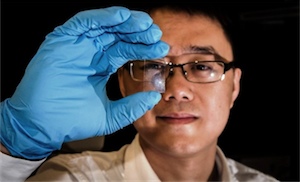Graphene sensors could boost light sensitivity 1000x
posted Friday, May 31, 2013 at 11:56 AM EST

A breakthrough in sensor technology could radically alter the way our cameras perform in low light -- but like any just published scientific research, there's a long and bumpy road before it reaches the consumer.
Researchers at the Nanyang Technological University have developed a new type of graphene light sensor, which has some immensely promising sounding capabilities, but is still a long way off from being commercially viable. The researchers created a single layer graphene based photodetector which is substantially more photo receptive than current graphene technology, and potentially 1,000 times as sensitive as a standard CMOS or CCD sensor. Not only that, but it's claimed to use 1/10th of the energy draw, and if it enters mass production, predicted to be five times cheaper to produce.
The research was published in the journal Nature Communications earlier this month, and the novel technique that allows this incredible sensitivity is creating nanostructures to "trap" electrons in place for a longer amount of time, thus allowing them to be registered. This is essentially done by inducing defects in the graphene itself, allowing the electrons excited as each photon is absorbed to be held in place. This not only means boosted sensitivity, but also the ability to read over a very wide area of the electromagnetic spectrum -- apparently it's particularly good "from the visible (532 nm) up to the mid-infrared (~10μm)" range.
Unfortunately, there's a rather obvious downside to this technology: speed. By trapping the electrons in place long enough to read them more accurately, you essentially freeze the sensor until they're dealt with, making for a rather slow sensor. According to the paper's authors, this delay can be reduced "by varying the types and the densities of defects". But reducing the lifetime of the trapped electron then also reduces sensitivity, thus requiring a balancing act between the two.
Since this technology is still in the very early stage, it probably won't make it to consumer devices for quite some time. It'll doubtless find a home in scientific imaging and astronomy first, where slow use is a perfectly valid tradeoff for extreme sensitivity -- especially in the infrared range. But you never know, 10 years from now you might be shooting your photographs on a graphene sensor rather than CMOS.
(via Science Daily, Engadget)